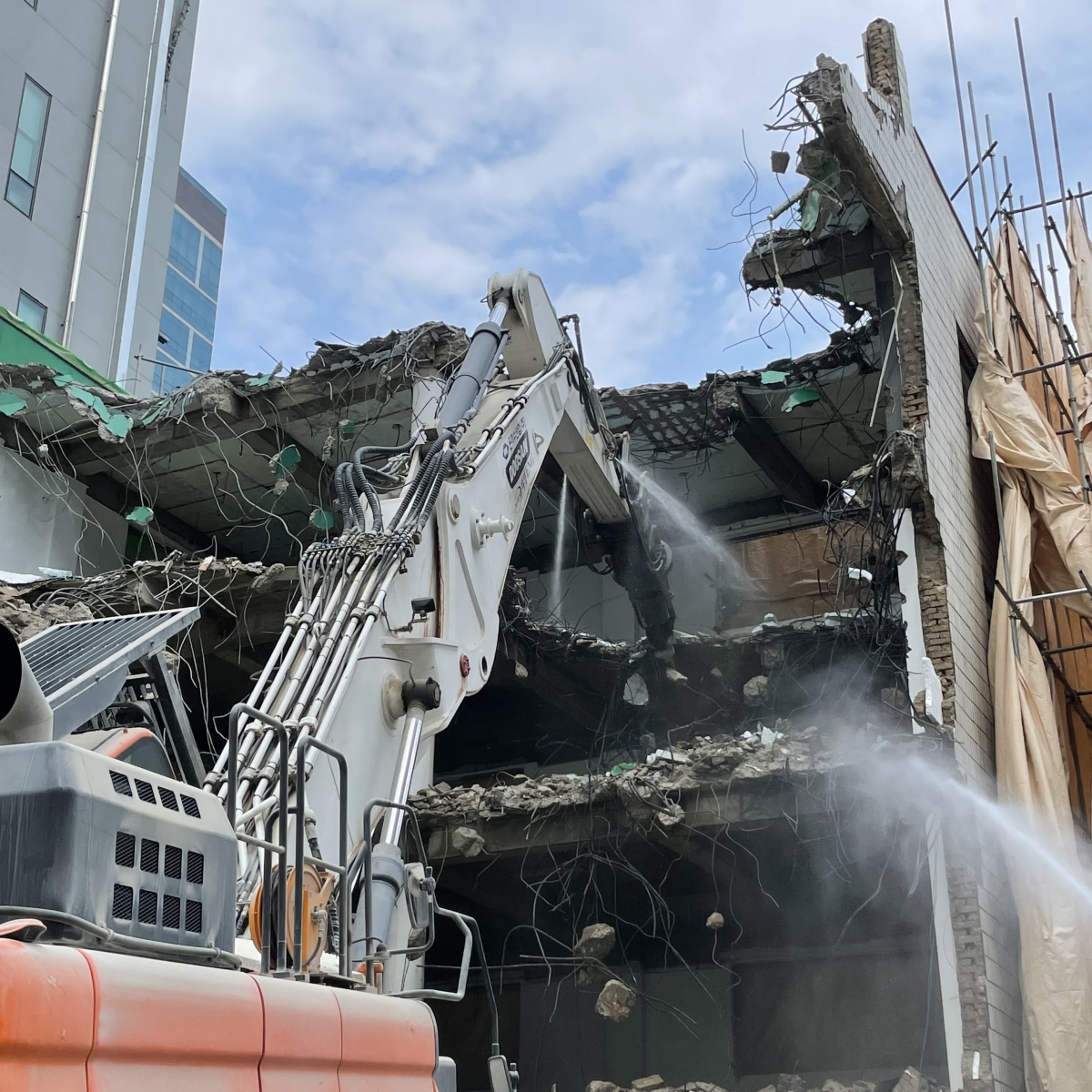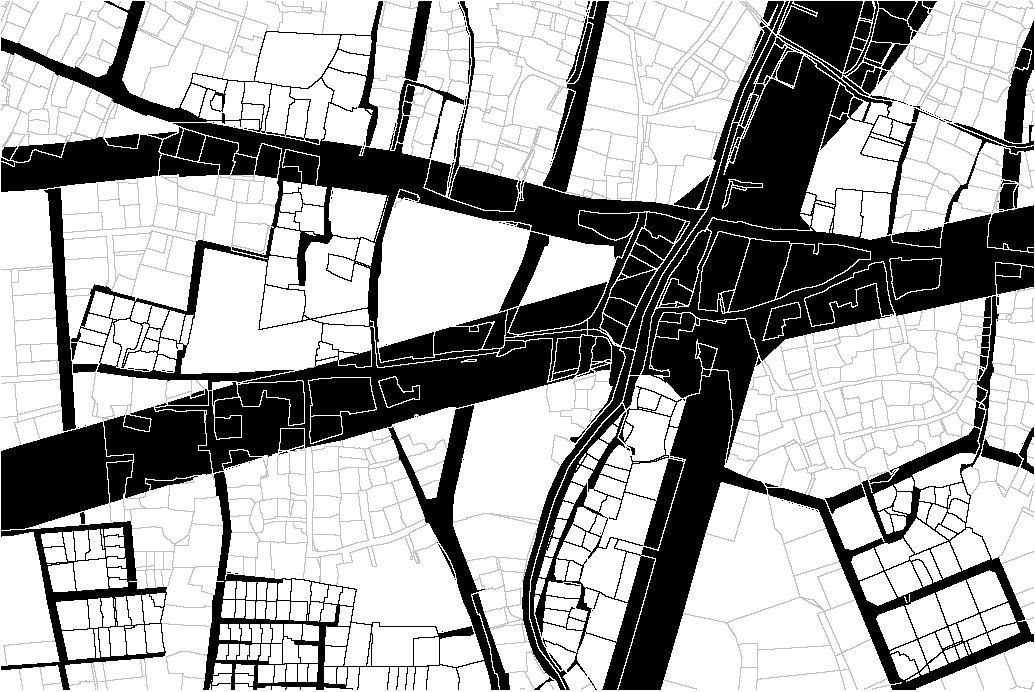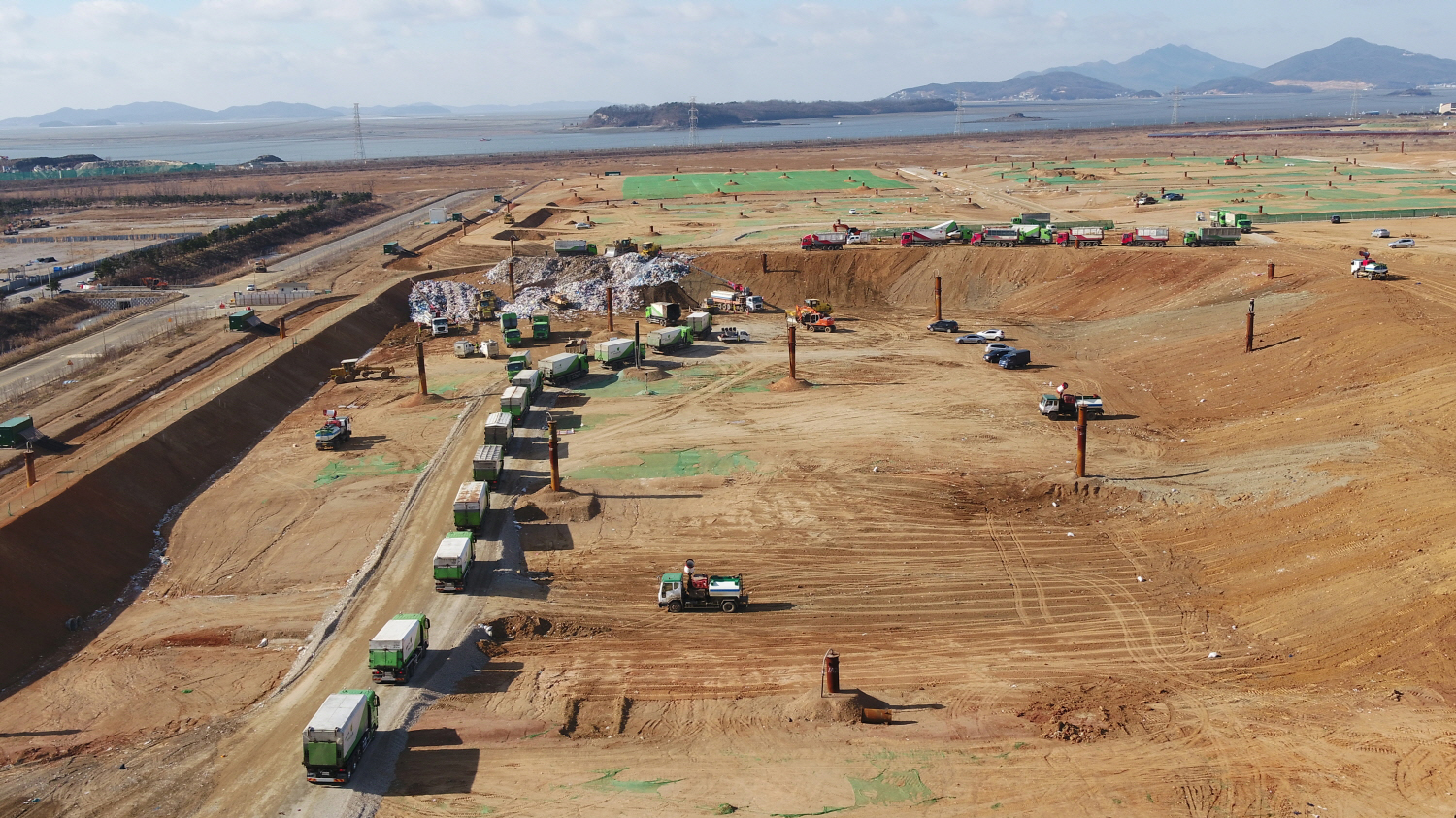While we all share the same planet, only a few of us have expressed concerns for the earth’s well-being and about the amount of damage wreaked upon nature. Making improvements to the convenience of our quality of life has now reached a state of no recovery, and we are now aware of the need to unite to tackle this shared challenge of our age described as climate change, or climate crisis. We must review what we have long taken for granted and ask ourselves: ‘does this threaten the environment?’ Correspondingly, what can we ask of architecture and what will improve our quality of life and human dignity in the midst of our ongoing climate emergency? What should we do? By reviewing a building’s life cycle from production, maintenance, and demolition, in the context of climate crisis, we will examine pertinent responses in this issue of SPACE.
STEP 3: During Demolition
Question 1: What Responsibility Does It Take to Demolish a Building and Build a New One?
Question 2: Where Does All the Construction Waste Go?
Question 3: How Does Korea Support the Circulation of Materials?

©Yu Heeryung
Resource-Circular Demolition in Response to Climate Change and Safety
written by Kim Hyojin head of Construction Technology Lab, Land & Housing Institute
To overcome environmental crisis, it is necessary to pursue economic development while also prioritising the preservation of the environment and saving our limited resources and energy. Therefore, a ‘circulating society’ emerged. That is to say, the entire process – from the collection of resources, construction using collected resources, the operation and maintenance of the constructed structure, to the demolition of the structure that has fulfilled is purpose and the recycling of waste resources from demolition – correlate in a method of circulating. In this life cycle, the environmental load at the stages of demolition of a building is estimated to be about 5%. It is lower than the environmental load at the stages of construction and operation, but in a circulating society, it is important to cope within every stage of the entire life cycle.
In terms of scale and speed, urbanisation in South Korea is growing at the one of the highest rates in the world. Many structures were built in tandem with the urbanisation of the 1970s and 1980s. The structures built at that time experienced a functional decline as they entered the 2010s and 2020s, thereby promoting urban regeneration projects. Currently, the number of potential buildings listed for demolition in Korea is estimated to be at about 3.2 million. It is inevitable that we face the issues around demolishing dilapidated structures. Not only is the number of structures to be demolished increasing, but higher and larger structures are becoming the subject of demolition. The number of demolished buildings is estimated to reach about 80,000 per year. Of them, more than 90% account for small-scale demolition work that consist of buildings that are less than three stories and a total floor area of below 500m2.
The term ‘demolition’ was often understood as ‘removal’. To make a finer distinction, ‘removal’ is the concept of randomly destroying a structure with the materials of interior decoration still intact, without considering the amount of waste debris generated. The dictionary definition of ‘demolition’ is to sequentially disassemble mechanical parts in the reverse order of assembly. In other words, to demolish is to first eliminate the numerous materials involved in interior decoration that may be generated as debris before destroying the entire structure, in order to raise the recycling rate of waste concrete. Today, the term ‘separating dismantlement’ is used to encompass these concepts. The seventh clause of Article 2 in the Building Management Act specifies that ‘demolition’ is ‘to destroy or to eliminate a building by cutting into the whole or part of it, in order to build, perform major repairs, remodelling, or total dispensing with the building’.
Construction site injuries caused by demolition work are frequent. A typical example is the breakdown that occurred during the demolition work of Hak-dong, Gwangju in June of this year, resulting in a large number of causalities. Prior to that, a breakdown occurred during the demolition work of the Nasan Department Store in Nonhyeon-dong, Seoul in October 2008. Before the breakdown in Gwangju, there was also breakdown that occurred during the demolition work in Jamwon-dong, Seoul in July 2019. As a result of such accidents, 1.16 people are injured per typical fatal accident, while the number of people injured per demolition and removal work is reaching 1.76 people, which is considered to be a quite high value.▼1 In particular, with a ratio of causalities at 7.4%, demolition and removal work accounts for the highest ratio of causalities in all construction works, when compared to that of other kinds of constructions. This is about twice as much as that of reinforced concrete construction.
The legal systems associated with demolition work can be divided into those related to the safety of demolition work and those related to improving the rate of recycling construction waste generated by demolition for resource circulation. A representative example of safety policies for demolition work are featured in the Building Management Act enacted in May 2020. This Act strengthened the system by making it mandatory to not only get permits and report on demolition work but also to review the demolition plan. That is to say, Clause 30 of the Act requires that managers must obtain permission from the permit holder when attempting to demolish a building. Yet, if a report is made for demolishing a building with a total floor area below 500m2, a height of below 12m, and that is less than three stories including the ground and basement floors, it is recognised that a permit has been obtained. In addition, according to Clause 31 of the Act, the permit holder is required to appoint a supervisor at the site of demolition work to oversee the building that has been approved for demolition. Amendments to the Building Management Act were proposed in July 2021 in the wake of the breakdown at the site of demolition work in Gwangju in June of this year. The amendments include the following: the mandatory installation of CCTV – for monitoring the demolition process at the site of large-scale building’s removal – or video recording of general site of removal; the review of the qualification of architectural structural engineers in the demolition plan of the building; the reinforcement of a discretionary on-site inspection of the permit holder into a mandatory one; the expansion in the range of people designated as supervisors for demolition work; the designation of a transient supervisor for the demolition sites that currently do not require a supervisor; the designation of general managers for all buildings in large areas such as local housing associations, redevelopment, and reconstruction; and the reinforcement of penalties for supervisors and contractors. The law for raising the recycling rate in resource circulation of construction waste generated by the demolition is the Construction Waste Recycling Promotion Act (hereinafter referred to as the Construction Waste Act), which was amended and promulgated in April 2019. The main reason for amendments to the Construction Waste Act is, in spite of the need to separate waste by type at a construction site, that mixed discharge at many sites worsens the recyclability of construction waste, possibly causing the degradation in the quality of the recycled aggregates that occur most frequently. This act is significant in that it requires ‘separating dismantlement’ of construction waste so that recyclable construction waste and the rest of the construction waste – which is difficult to recycle – do not get mixed with each other. That is to say, when the national government, local governments, or public institutions commission a project for demolition of structures that fall under the categories of a certain structure, scale, and usage, it becomes mandatory to discharge construction waste separately through separating dismantlement. The purpose of this reinforcement is to activate the recycling of recycled aggregates produced by processing construction waste generated from the demolition of structures. This Act came into force on the 17th of April 2020 a year after its promulgation. However, the amended regulations of item 2 in the twelfth Clause of Article 2, the third clause of Article 4, and the second Clause of Article 5, which are related to separating dismantlement, came into force on the 17th of April 2021, two years after the promulgation. In addition, the enforcement ordinance of the Construction Waste Act stipulates the structures that are subject to separating dismantlement and the waste subject to prior elimination. In other words, when the national government, local governments, or public institutions intend to demolish a building with a floor area of more than 500m2, construction waste such as wood waste must be eliminated before demolition. As a footnote, Japan enacted the Construction Recycling Act in 2003, making separating dismantlement mandatory. The gist of this act is that it is now mandatory to perform separating dismantlement when demolishing a building with a floor area of more than 80m2 or when erecting a new building or an extension of a building with a floor area of more than 500m2. Japan has announced that this act has raised the recycling rate of demolition debris to 75%. European countries such as Germany also recommend performing separating dismantlement, even if it is not mandatory.
Buildings erected around the 1980s have reached the point of official demolition. Furthermore, higher and larger structures are becoming the subject of demolition. As a result, accidents on the demolition work sites are occurring more frequently. Not only does demolition work discharge a large amount of environmental pollutants such as noise, vibration, and dust, but also hazardous substances such as asbestos and carbon dioxide from the equipment used for demolition, which triggers climate change. Therefore, it is necessary to continuously improve laws and systems related to demolition work, in order to tighten safety management on construction sites, make efforts to preserve our global environment, and respond to climate change.
First, institutional blind spots must be reduced through the continuous tightening of systems and regulations, in order to reduce the incidence of negligent accidents frequently occurring at the demolition work site, which is relatively high when compared to that of other types of work. Demolition is also a phase that discharges a large amount of waste that is accumulated after construction and building operations. Therefore, in order to reduce the consumption of natural resources by improving the recycling rate of waste resources generated, it is necessary to expand the number of structures subjected to separating dismantlement to the same level as that of Japan. Thus, it is necessary to make constant and sensitive improvements to the legal system. And it is important to make continuous efforts, and to improve and tighten the systems that reduce the occurrence of substances that trigger climate change, such as carbon dioxide and various environmental pollutants, generated in demolition work. (written by Kim Hyojin / edited by Choi Eunhwa)
▼
1. Korea Occupational Safety and Health Agency, Standard for Safe Work Procedures of Demolishment Construction, Ministry of Employment and Labor, 2017.






